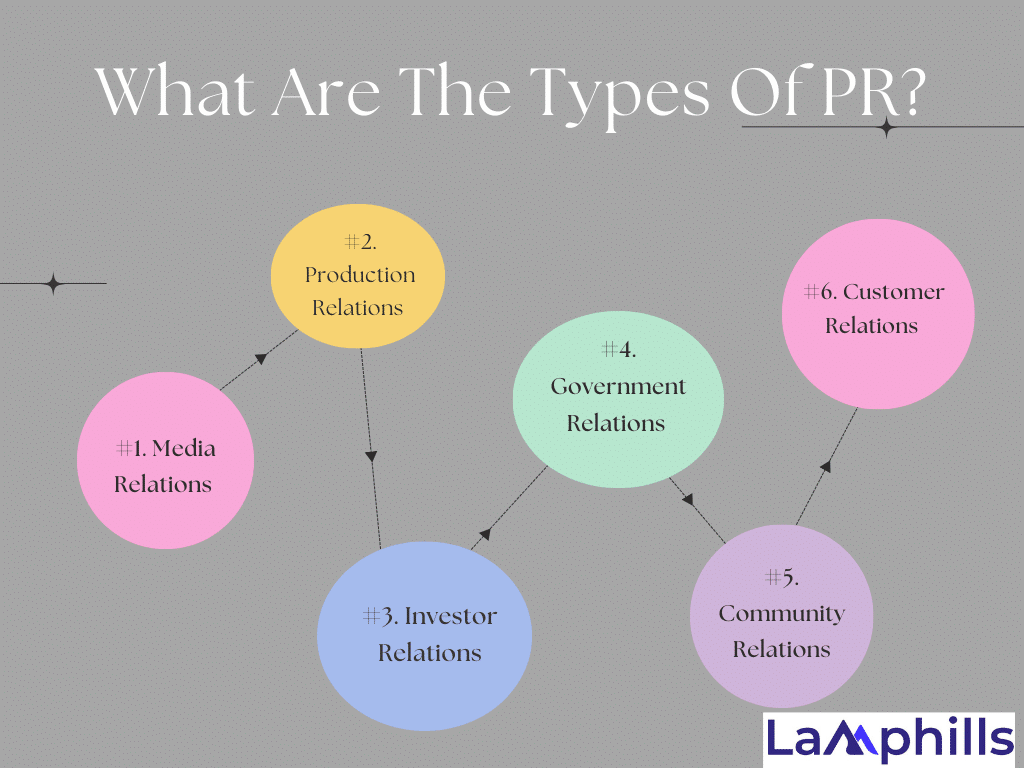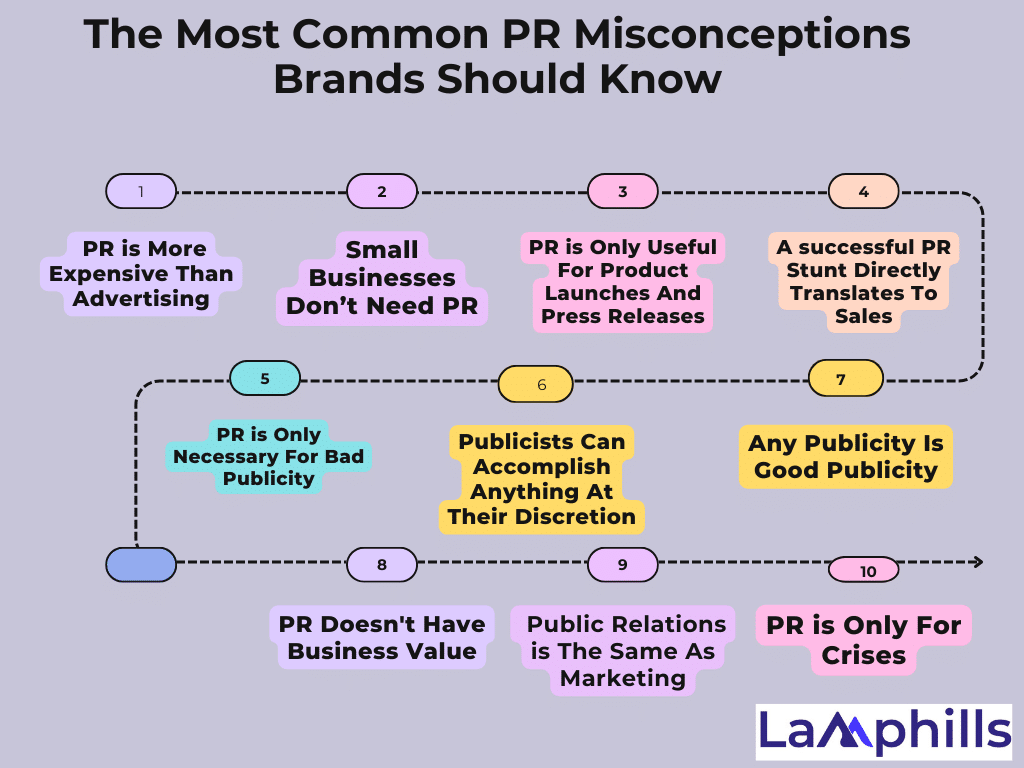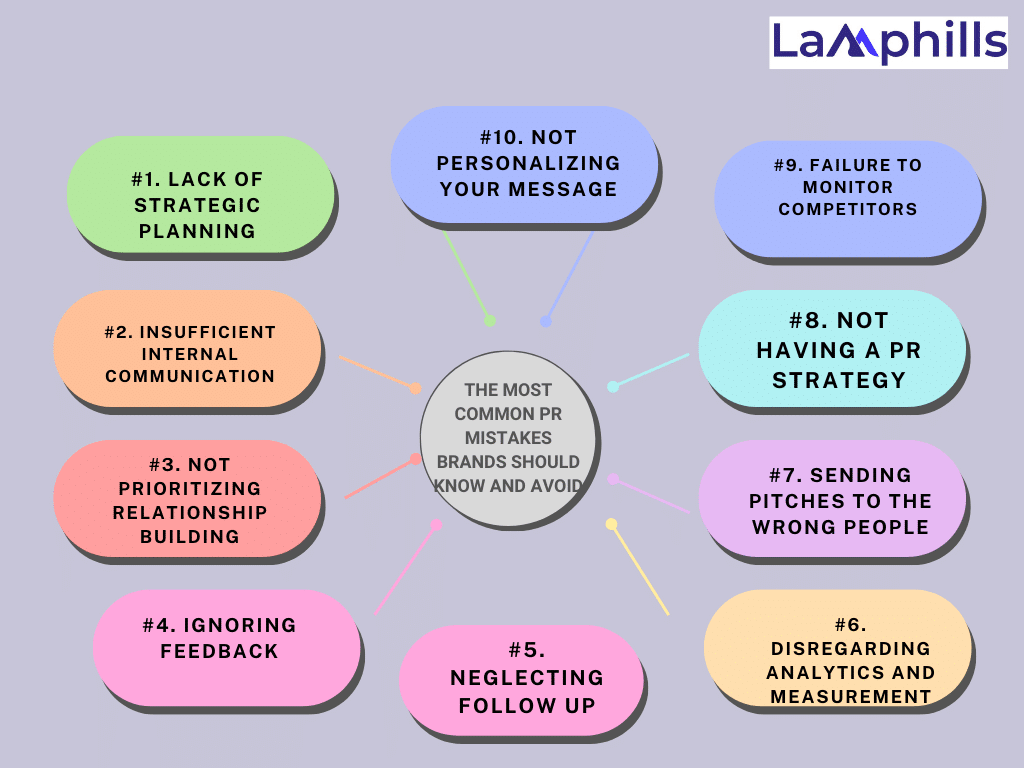Public relations (PR) is frequently seen as a mysterious aspect of brand management; some companies excel at it, while others make infamous mistakes. However, the truth is that PR errors may happen to even the most reputable businesses. I have direct experience with how small and large brands can repeatedly encounter the same problems. Experience has shown me that some of these errors can be avoided with a little forethought and preparation.
Strategic execution and meticulous planning are necessary for public relations. Yet even seasoned public relations specialists can make errors that impede progress. In this article, I’ll address frequent misunderstandings and common errors in PR, followed by helpful advice on how to avoid them. By being aware of these pitfalls and implementing the right strategies, you can build a winning plan that effectively communicates your brand or client’s story!
Key Takeaways
- A clear and well-defined PR strategy is crucial for effective communication. Without it, brands may struggle to align their messaging and miss their objectives, making planning an essential part of PR success.
- Many brands mistakenly believe that PR is only needed during negative events or crises. However, maintaining a consistent PR effort throughout the year helps to build trust, credibility, and familiarity with the audience, which can prevent potential crises.
- A common misconception is that PR is the same as advertising or solely about managing negative press. Unlike advertising, PR focuses on earning organic visibility and fostering positive relationships, which is fundamental for long-term brand reputation.
- Neglecting relationships with journalists and media influencers can result in missed opportunities for positive coverage. Investing in building strong connections is vital for ensuring beneficial media partnerships and positive public perception.
- PR is not just for large corporations—small businesses can greatly benefit from it too. Effective PR strategies help smaller brands build awareness, gain credibility, and connect genuinely with their target audience.
What Is Public Relations (PR)?

Public relations (PR) is the collection of methods and plans used to control the public’s and media’s access to information about a person or organization. Disseminating significant company news or events, upholding brand image, and casting a positive light on unfortunate occurrences to lessen their impact are its core objectives.
Press releases from businesses, press conferences, journalist interviews, social media posts, and other formats are some examples of how PR can happen. Public dissemination of information about them or their actions is a challenge for any person or organization that operates in the public eye. Even though it’s its industry, public relations may be defined as any attempt to present oneself to others in a particular light—a form of public relations.
Understanding Public Relations (PR)
Though it isn’t explicitly stated in the definition, PR is frequently referred to as “spin” to present the subject, organization, or brand in the most favorable light possible. The way that public relations (PR) and advertising work together to portray a person or brand is that PR aims to do so in ways that will seem natural, like getting positive coverage from unbiased sources and suggesting business moves that the public will support.
One of the US industries with the quickest growth rates is public relations, which was only loosely defined until the middle of the 20th century. Every business needs it to succeed, but it becomes even more crucial when shares are traded publicly and a company’s value is based on how confident the public is in its products or services.
PR experts are typically in charge of creating and upholding the company’s image in addition to responding to information requests, media requests, and shareholder complaints. Although such actions are against the industry’s code of ethics, PR practitioners occasionally participate in negative PR or deliberate attempts to disparage a competitor brand or firm.
What Are The Types Of Common PR?

Public relations is often divided into different agencies or departments. Each department is specifically suited to handle a specific aspect below:
#1. Media Relations
This is the emphasis on forging a strong relationship with public media organizations. A media relations team often works directly with external media by directly delivering them company news, providing validated content sources, and being accessible for public comment on other news stories.
#2. Production Relations
They are closely related to the direct operations of a company. This department supports broad marketing plans and is often related to specific, one-time endeavors such as the launch of a new product, a special campaign, or the management of a major product change.
#3. Investor Relations
This is the oversight of the relationship between the company and its investors. This aspect of public relations handles investor events, oversees communication of the release of financial reports, and handles investor complaints.
Is the public relations branch between a company and its employees? Internal relations pertain to counseling employees, ensuring all workers are satisfied with their working conditions, and mediating issues internally to avoid public disclosure of dissatisfaction.
#4. Government Relations
the connection between a company and related governing bodies. Some public relations departments want to forge a strong relationship to provide feedback to politicians, sway decision-makers to act in specific ways, and ensure fair treatment of the company’s clients.
#5. Community Relations
This is public relations focused on brand and reputation within a specific community. The community could be physical (i.e., a specific city) or nonphysical (i.e., the dog-owner community). This branch of public relations keys in on the social niche of the community to align itself with its members.
#6. Customer Relations
This is the bridge that connects the company and its customers. Public relations often involves handling key relationships, conducting market research, understanding the priorities of its customers, and addressing major concerns.
The Most Common PR Misconceptions Brands Should Know

My public relations career began more than a decade ago. It’s been more than a decade since I enrolled in Public Relations & Communications as an undergraduate. Back then, my relatives and friends would ask me, “So, what exactly is public relations?” Since then, I’ve discovered that many people have no idea what PR is in general!
I believe it was about the two-year point of studying public relations that I nearly gave up addressing questions like, “Isn’t that just advertising?” “So you sit on Twitter and LinkedIn all day?” , nor “So you try to cover up negative stories?”
And, when you meet more individuals in life, you strive to decide on better ways to convey your role and what you do day-to-day, whilst also anticipating an explanatory answer to many of the questions that arise after you say, “I work in PR.” I’ve found, after many years of doing so, it’s often easier to tell people what PR isn’t, as opposed to what it is—so here are incredibly common misconceptions about PR I am here to bust.
#1. PR is More Expensive Than Advertising
This is one of the most common ideas I’ve encountered in my time as a public relations consultant. While both activities help brands connect with their target consumers, there is a difference in the expenses and tactics involved in promoting a business. Advertising is bought visibility, but PR is earned visibility, giving the perception that PR is more laborious and difficult.
Fortunately, public relations does not need to be as expensive as advertising. You can determine which public relations methods are most effective for your brand. There are many fantastic and competent PR agencies and freelancers out there that offer good offers without breaking the bank.
#2. Small Businesses Don’t Need PR
People frequently assume that the only eligible clients in need of PR services are major corporations and well-known celebrities. However, the majority of my clients are small business owners who recognize the value of having a public relations team. While a big brand or product launch is not necessary for startups, they still need to tell their narrative and present their businesses in the best possible light. Every company must establish credibility, build brand recognition, and establish a sincere relationship with its target market. Whether it’s a tiny business or a large worldwide brand, PR can help achieve all of these goals.
#3. PR is Only Useful For Product Launches And Press Releases
Although these events are common in the PR scheme, it doesn’t mean that’s all there is to it. PR has other strategies, such as cross-promotion, business events, social media marketing, influencer relations, crisis management, etc. As my clients delved deeper into PR, they realized the extent of what it can do and the endless possibilities of boosting the brand’s reputation and exposure.
#4. A successful PR Stunt Directly Translates To Sales
Every business owner hopes for a big hit when a public relations campaign goes viral, but sales don’t always follow a million views. To be clear, PR won’t suddenly turn you into a multibillionaire company magnate. On the other hand, it raises the visibility and influence of your brand, which could result in higher conversion rates. The key is to consistently establish your reliability and dependability in your market. To do that, even after your content goes viral, you still need to regularly engage with your target audience by talking to them, connecting with them, and showing up for them.
#5. PR is Only Necessary For Bad Publicity
Businesses that buy into this idea ultimately commit grave errors. The PR department handles crises and damaged reputations, but if the brand’s base isn’t strong enough, fixing the damage could not be as successful. Sometimes, once the harm has been done, it may already be too late to repair the situation. To help you pursue your entrepreneurial journey and prevent issues and potential catastrophes in the first place, it is important to have these PR professionals in the early stages.
#6. Publicists Can Accomplish Anything At Their Discretion
While PR representatives are adept communicators with a wide range of skills, they are not magicians who can perform miracles or summon results instantly. Rather, PR helps businesses stand out in a sea of competition, secure media coverage, and avoid traps that could damage reputation. Also, remember that time is essential for a plan to become successful and bear beneficial results.
#7. Any Publicity Is Good Publicity
Remember when a well-known brand received blowback for a poorly handled social media campaign? They anticipated that even unfavorable publicity would generate interest. But they didn’t realize how much damage it would do to their reputation. It got people talking, but not in a positive way. The idea that “any publicity is good publicity” can be extremely deceptive.
Negative press can lead to lost trust, a tarnished reputation, and even a drop in revenue. For example, I previously worked with a tech business that got into hot water after a provocative tweet. They expected the excitement to boost traffic to their website, but they ended up spending months trying to restore the damage to their reputation.
That’s not to say all hope is lost if you find yourself in a PR crisis. It’s all about how you respond. The startup I mentioned earlier managed to turn things around by issuing a heartfelt apology, taking accountability, and making genuine efforts to change their practices. The key is to address negative PR head-on, learn from the experience, and show that you’re committed to doing better.
#8. PR Doesn’t Have Business Value
Because there is no common measure of a PR strategy’s success or failure, some business owners believe that, unlike advertising, PR is an additional investment with no tangible and immediate results. Fortunately, the effects of public relations can be quantified by looking at the quantity of news coverage received, the number of hits or visits to a website, an increase in engagement and reach, and many other factors.
#9. Public Relations is The Same As Marketing
This is likely the most common fallacy, with many individuals believing there is no distinction between PR and marketing. While the two can function well together as part of a larger communications plan, they are not the same thing.
Marketing is focused on ultimately selling products and services to the audience, whether through digital or traditional means. The goal of PR is to establish mutually beneficial partnerships that are based on “earned” media. This includes exposure gained through news mentions, customer reviews, podcast appearances, and a host of other opportunities.
#10. PR is Only For Crises
Use these templates and guidelines to prepare, respond, and learn from each situation, turning challenges into opportunities for growth and improvement
While crisis management is an important aspect of public relations, it is far from the only time that brands should spend in their communications. Ideally, public relations should be a continual activity that is pursued throughout the year, as this is what will ultimately contribute to a brand’s trust, familiarity, and credibility.
Many potential crises can be averted entirely if your public relations strategy and communications are proactive from the start. Though a single crisis does not always signal disaster for a business, maintaining a positive reputation is significantly easier than repairing a damaged one, so investing in public relations early on pays off.
The Most Common PR Mistakes Brands Should Know And Avoid

Public relations necessitates meticulous planning and smart execution. However, even experienced public relations professionals make blunders that might jeopardize success. In the following section, I’ll identify ten common PR mistakes and offer concrete advice on how to avoid them. By being aware of these dangers and using the appropriate tactics, you can create a successful strategy for effectively communicating your brand’s or client’s narrative!
#1. Lack Of Strategic Planning
One of the most common PR mistakes made by public relations professionals is failing to develop a clear and well-defined strategy. Without a strategic strategy, you may lose direction and struggle to successfully express your message to your target audience.
How Can You Avoid This?
It’s crucial to create a detailed PR plan. This plan should clearly outline your objectives, define your target audience, establish key messages, and outline the tactics (and measurement) you will use to achieve your goals.
By having a well-thought-out strategy, you can ensure that every PR activity aligns with your overall objectives and helps you reach your desired outcomes.
#2. Insufficient Internal Communication
Another common mistake made by public relations professionals is failing to communicate clearly within the firm and with internal stakeholders. Poor communication can lead to misunderstandings, confusion, and problems with key persons in the business.
How Can You Avoid This?
PR professionals must ensure that their communications are simple to understand, consistent, and resonate with their target audience. Establishing good communication channels inside the organization is critical, as is providing clear guidelines for information exchange. Fostering excellent internal communication ensures that everyone is on the same page and working toward common goals.
#3. Not Prioritizing Relationship Building
Developing solid ties with the media is an important part of public relations. However, some public relations professionals fail to devote time and effort to networking with journalists and opinion leaders. This can lead to missed opportunities for media coverage or even unfavorable PR.
How Can You Avoid This?
It is critical to actively communicate with journalists, bloggers, and other media influencers. Take the time to learn their requirements and interests. Provide them with current and relevant information.
Establishing mutually beneficial partnerships increases your chances of receiving positive media coverage and developing a great reputation.
#4. Ignoring Feedback
Public relations professionals can make the mistake of not listening to their audience or neglecting to adapt their strategy as external conditions change. This might cause a loss of trust and relevancy. While negative criticism may be unpleasant, it can provide important insights for learning and progress.
How Can You Avoid It?
Public relations professionals should analyze and evaluate their strategies on a frequent basis. Seek comments from key stakeholders, such as journalists and influencers. Be willing to make the required changes to improve your public relations efforts.
You may strengthen your relationships and increase the efficacy of your public relations efforts by actively listening to and adjusting to your audience’s requirements.
#5. Neglecting Follow Up
Following up on your PR proposal or idea is critical to ensuring that journalists are interested. Failure to follow up may result in missed chances and a lack of response from media professionals.
How Do You Prevent This?
Make it a point to contact journalists and influencers once you send your pitch. Remind them politely of your essential points, personalizing your correspondence with their name. Create engaging information that promotes further discussion or collaboration.
#6. Disregarding Analytics and Measurement
Common PR measurement must be used to review and improve pitches, press releases, and social media posts to be effective. By ignoring analytics and measurement, you lose vital information that might help you adjust your plans and achieve greater results.
How Can You Avoid It?
It is critical to embrace data-driven PR approaches. To assess the success and impact of your operations, use public relations solutions that have analytics and measurement capabilities.
Identify what is functioning well and what may be improved. By utilizing data, you can constantly improve your strategy and increase the efficacy of your public relations activities.
#7. Sending Pitches To the Wrong People
Sending your pitch to the wrong media is like sending a birthday card to the incorrect address: it’s unlikely to produce the desired outcomes. It is critical to perform extensive research to locate the appropriate journalists, bloggers, or influencers who share your target audience.
How Can You Avoid This?
Before you make your pitch, spend some time investigating the people or media outlets you intend to approach. Ensure that their target audience matches yours and that your message is relevant to their interests. Familiarize yourself with their preferred communication style, and modify your pitch accordingly. By submitting your pitch to the proper people, you boost your chances of receiving media attention and reaching your target audience.
#8. Not Having a PR Strategy
Early in my career, I worked for a small company that was excellent at their job but used a scattergun approach to public relations. They’d seize any media opportunity that presented itself, regardless of how it related to their brand values or long-term aims. It became evident that they lacked a comprehensive public relations plan, as evidenced by how they portrayed themselves to the public.
Without a strategy, your public relations activities can be incoherent and reactive. You might get an interview in a local newspaper for one week and then disappear from the public eye for months. Inconsistency can lead to confusion and dilute your brand message.
How to fix it
Begin by establishing clear PR goals that are consistent with your overall business goals. Do you want to increase brand awareness, improve your reputation, or position your organization as a thought leader in your industry? Once you’ve established your goals, make a plan outlining your core messaging, target media channels, and engagement strategies.
I learned this the hard way, but I now highlight the significance of having a sound PR strategy. And believe me, it’s worth it!
#9. Failure To Monitor Competitors
In public relations, it is critical to monitor what your competitors are doing. If you fail to watch your competitors’ public relations initiatives, you risk losing critical information and opportunities to keep ahead of the competition.
How Can You Avoid This?
Analyze your competitors’ coverage and social media presence regularly using media monitoring and social listening tools. Identify your chosen media outlets and industry relevance.
Understanding what works for your competition and what doesn’t allows you to obtain vital insights and learn from their triumphs and failures. Stay up to date on market developments and implement them into your public relations efforts to preserve a competitive advantage.
#10. Not Personalizing Your Message
Sending a generic message to everyone you pitch is a definite way to lose their attention. To catch their interest and engagement, tailor your message to each journalist or media outlet.
How Can You Avoid It?
Demonstrate that you have done your study and understand their preferences and interests. Tailor your message to their normal topics or offer something useful to their readers. By exhibiting a true grasp of their wants and interests, you boost your chances of capturing their attention and interest in your public relations pitch.
Conclusion
PR doesn’t have to be a mystery, and with the right approach, you can avoid these common mistakes and misconceptions. Whether you’re a small business owner or leading a large brand, understanding the mistake of PR can help you build trust, credibility, and long-term success. And remember, every misstep is a chance to learn—take it from someone who’s seen the good, the bad, and the “how-did-we-not-see-that-coming” of the PR world.






